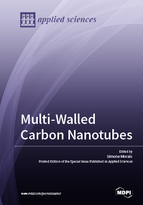Multi-Walled Carbon Nanotubes
A special issue of Applied Sciences (ISSN 2076-3417). This special issue belongs to the section "Nanotechnology and Applied Nanosciences".
Deadline for manuscript submissions: closed (30 November 2018) | Viewed by 57496
Special Issue Editor
Interests: (bio)sensors; application of functional nanostructured materials; green technologies; new methodologies for (electro)analysis; environmental chemistry; monitoring/biomonitoring
Special Issues, Collections and Topics in MDPI journals
Special Issue Information
Dear Colleagues,
Since their discovery, Multi-Walled Carbon Nanotubes (MWCNTs) have received tremendous attention due to their unique electrical, optical, physical, chemical, and mechanical properties. Remarkable advances have been made in the synthesis, purification, structural characterization, functionalization, and application of MWCNTs. Their particular characteristics make them well-matched for a plethora of application areas, namely nanoelectronics, energy management, (electro)catalysis, materials science, the construction of (bio)sensors based on different detection schemes, multifunctional nanoprobes for biomedical imaging, sorbents for sample preparation or removal of contaminants from wastewater, as anti-bacterial agents, drug delivery nanocarriers, etc.; current relevant application areas are countless.
The aim of this Special Issue is to publish original research and review articles that address advances, trends, challenges, and future perspectives regarding synthetic routes, structural features, properties, behaviors, and industrial or scientific applications of MWCNTs in established and emerging areas.
Prof. Dr. Simone Morais
Guest Editor
Manuscript Submission Information
Manuscripts should be submitted online at www.mdpi.com by registering and logging in to this website. Once you are registered, click here to go to the submission form. Manuscripts can be submitted until the deadline. All submissions that pass pre-check are peer-reviewed. Accepted papers will be published continuously in the journal (as soon as accepted) and will be listed together on the special issue website. Research articles, review articles as well as short communications are invited. For planned papers, a title and short abstract (about 100 words) can be sent to the Editorial Office for announcement on this website.
Submitted manuscripts should not have been published previously, nor be under consideration for publication elsewhere (except conference proceedings papers). All manuscripts are thoroughly refereed through a single-blind peer-review process. A guide for authors and other relevant information for submission of manuscripts is available on the Instructions for Authors page. Applied Sciences is an international peer-reviewed open access semimonthly journal published by MDPI.
Please visit the Instructions for Authors page before submitting a manuscript. The Article Processing Charge (APC) for publication in this open access journal is 2400 CHF (Swiss Francs). Submitted papers should be well formatted and use good English. Authors may use MDPI's English editing service prior to publication or during author revisions.
Keywords
-
Multi-walled carbon nanotubes
-
Catalysis
-
Characterization
-
Drug delivery systems
-
Energy management
-
Functionalization
-
Nanoelectronics
-
Nanoprobes and (bio)sensors
-
Purification
-
Synthesis






